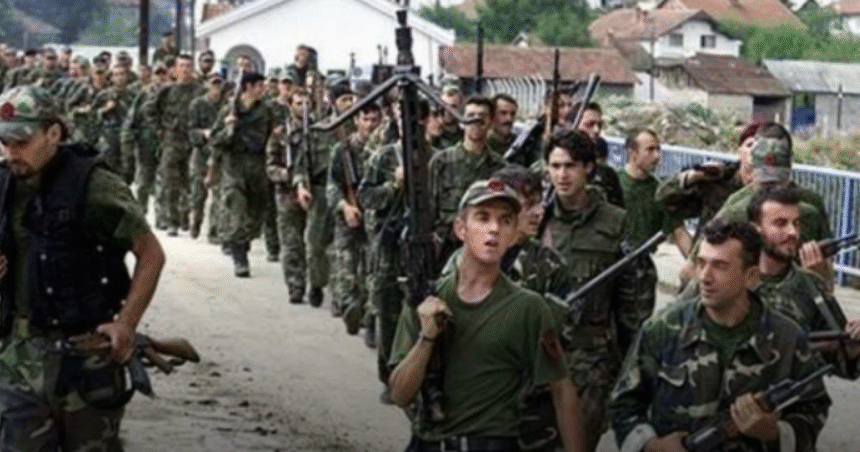Today marks 26 years since the signing of the agreement for the demilitarization of the Kosovo Liberation Army (KLA), which detailed the phases of weapons handover, retention of uniforms, integration of some KLA members into police and public administration, among other elements.
The agreement foresaw the eventual formation of a Kosovo Army modeled on the U.S. National Guard, taking into account the terms of the Rambouillet Agreement.
This entire phase lasted 90 days, after which the full demilitarization of the KLA was completed. In September 1999, an agreement was signed for the formation of the Kosovo Protection Corps (KPC), not as a military force as originally envisioned, but as an emergency response force for natural disasters.
The signatories of this agreement were: Hashim Thaçi as the KLA’s Supreme Commander, Agim Çeku as Chief of General Staff, and it was accepted by Lieutenant General Mike Jackson, Commander of KFOR.
Below is the full text of the agreement reached on Sunday, June 21, 1999:
AGREEMENT FOR THE DEMILITARIZATION OF THE KOSOVO LIBERATION ARMY (KLA)
On Sunday evening, the text of the demilitarization agreement of the Kosovo Liberation Army was signed by the Supreme Commander of the KLA, Hashim Thaçi; Chief of the KLA General Staff, Agim Çeku; and KFOR Commander, Lieutenant General Mike Jackson. The full text of the agreement is as follows:
a) The KLA includes all personnel within Kosovo under KLA control, possessing military or paramilitary capabilities, as well as any other groups or individuals designated as such by the KFOR Commander.
The KLA intends to act in accordance with the terms of UN Security Council Resolution 1244. In this context, the international community is asked to recognize the KLA’s contribution during the Kosovo crisis and, based on that, to:
Accept that while the KLA and its structures are in the process of transformation, it is committed to proposing individual members to participate in policing and administrative functions in Kosovo, giving special consideration to the experience they have gained.
Support the formation of a Kosovo Army modeled on the U.S. National Guard, as part of the political process to determine Kosovo’s future status, considering the Rambouillet Agreement.
The KLA’s Initiative for Demilitarization
This initiative enables the ceasefire of the KLA, their disengagement from conflict zones, subsequent demilitarization, and reintegration into civilian society, in line with UNSC Resolution 1244 and commitments made in Rambouillet.
The KLA undertakes to renounce the use of force, comply with the directives of the international security force commander in Kosovo (COMKFOR), and resolve all issues peacefully related to this initiative’s implementation.
The KLA agrees that the international security presence (KFOR) and international civilian presence will be deployed and operate freely within Kosovo, with KFOR authorized to take all necessary actions to maintain a secure environment and fulfill its mission.
The KLA commits to immediately ensuring that all its forces in Kosovo and neighboring countries adhere to this initiative, abstain from hostile or provocative acts, and freeze all military movements across international borders and within Yugoslavia (FRY), as per UNSC Resolution 1244.
The KLA will make a public commitment to demilitarize according to paragraphs 22 and 23, refrain from activities endangering the security of international governmental and non-governmental personnel, including KFOR, and facilitate KFOR’s deployment and operations.
Definitions for this initiative:
KLA: All military/paramilitary personnel under KLA control in Kosovo and other individuals/groups designated by COMKFOR.
FRY Forces: All personnel of the FRY and Republic of Serbia military and paramilitary organizations, including regular army, navy, armed civilian groups, special forces, intelligence services, Ministry of Interior units, etc.
Ground Safety Zone (GSZ): A 5-kilometer strip beyond Kosovo’s border within FRY territory.
Prohibited Weapons: All weapons over 12.7 mm caliber, anti-tank/aircraft weapons, grenades, mines, explosives, and long-barrel firearms.
Objectives of this initiative:
Establish a sustainable ceasefire.
Empower and authorize KFOR to act, including using necessary force, to ensure this initiative’s implementation and provide a secure environment for all international actors and civilians.
COMKFOR, in coordination with the interim civilian administrator, will have ultimate authority on security matters and this initiative’s interpretation. His decisions are binding on all parties and individuals.
Ceasefire
Upon signature, the KLA agrees to:
Follow this initiative and COMKFOR’s directives.
Immediately cease all hostile acts.
The KLA Chief of General Staff will issue clear orders to all units to ensure contact with FRY forces is prevented and compliance with this agreement is achieved.
Specific KLA Obligations:
Cease fire and use of explosives.
Avoid setting up checkpoints, barriers, or military outposts.
Do not engage in military, security, or training activities without COMKFOR’s prior approval.
Do not attack, detain, or interrogate civilians; do not seize or damage civilian property.
The KLA will refrain from counterattacks or retaliatory actions and will not obstruct authorized FRY personnel returning to Kosovo under COMKFOR oversight.
Without COMKFOR approval, KLA members will not carry weapons:
Within 2 km of FRY/Serbian Army or police positions.
Within 2 km of major roads or designated cities.
Within 2 km of Kosovo’s borders.
In any area designated by COMKFOR.
Within Four Days of Signing:
The KLA will close all combat positions and mark any mines or booby traps it has placed.
The Chief of General Staff will submit a written report to COMKFOR and continue weekly updates until demilitarization is complete.
Border Activities
The KLA will stop armed movements across neighboring countries. Armed movements within Kosovo will require prior COMKFOR approval.
Monitoring & Ceasefire Enforcement
COMKFOR is authorized to enforce compliance with this initiative. The KLA will fully cooperate with KFOR and the interim civilian administration.
KFOR units will maintain contact with the KLA and be stationed at its command structures and bases. KFOR will also control border crossings with Albania and Macedonia.
Joint Implementation Commission (JIC)
A JIC will be established in Pristina within four days of signing, led by COMKFOR and including senior KFOR and KLA commanders and one international civilian representative.
It will:
Ensure coordination and security arrangements.
Investigate violations or threats to the initiative.
Handle other duties assigned by COMKFOR to maintain the ceasefire.
Demilitarization and Transformation
The KLA will follow COMKFOR-approved phased demilitarization, transformation, and monitoring procedures and will not conduct unauthorized parades.
Timeline:
7 Days: Set up registered arms depots to be jointly verified by KFOR.
7 Days: Clear mines, abandon combat positions, and move to approved locations.
14 Days: Only authorized personnel with handguns may exit approved areas.
29 Days: Long-barrel weapons not in depots will be subject to COMKFOR decision.
30 Days: Non-local KLA personnel (foreign fighters, volunteers, etc.) to leave Kosovo.
30 Days:
All prohibited weapons placed in depots.
30% of small arms also placed in depots.
Ammunition stored in separate locations designated by COMKFOR.
Day 30: Possession of prohibited/long-barrel weapons is banned; KFOR will confiscate.
Day 30: Another 30% of small arms will be stored (total 60%).
Day 90: All automatic weapons to be stored. Possession by KLA members banned; KFOR to confiscate.
From day 30–90, depots will be jointly controlled by KLA and KFOR. After day 90, KFOR will assume full control.
By day 90, all KLA units will complete demilitarization and cease wearing military uniforms or KLA insignia.
The KLA Chief of General Staff will confirm compliance in writing to COMKFOR.
This initiative takes immediate effect upon signature by the Kosovo Albanian representatives.
Note: This agreement was written in both English and Albanian; in case of any discrepancy, the English version shall prevail.
Signed by:
Hashim Thaçi, Supreme Commander of the Kosovo Liberation Army
Lt. Gen. Mike Jackson, KFOR Commander
Date: June 21, 1999
Designated Routes:
Peja–Llapushnik–Pristina
Border–Gjakova–Klina
Border–Prizren–Suhareka–Pristina
Gjakova–Rahovec–Llapushnik–Pristina
Peja–Gjakova–Prizren–Ferizaj–Border
Border–Ferizaj–Pristina–Podujeva–Border
Pristina–Mitrovica–Border
Mitrovica–Rakosh–Peja
Peja–Montenegro Border (via Rozhaja)
Pristina–Lisica–Serbia Border
Pristina–Gjilan–Ferizaj
Gjilan–Tërnoc i Madh–Serbia Border
Prizren–Doganoviq







